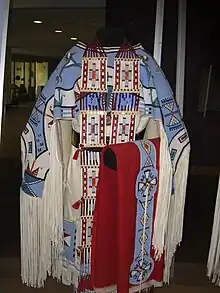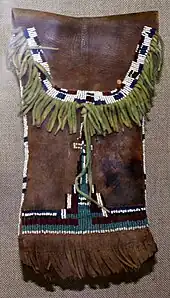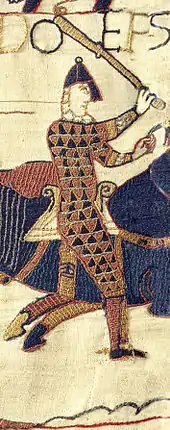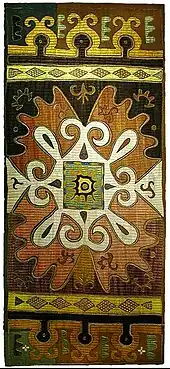Juanita Growing Thunder Fogarty
Juanita Growing Thunder Fogarty (born 1969) is a Native American, Assiniboine Sioux bead worker and porcupine quill worker. She creates traditional Northern Plains regalia.[1][2]
Juanita Growing Thunder Fogarty | |
|---|---|
 Give Away Horses dress (2006) created by Fogarty, her mother, Joyce, and daughter, Jessa Rae. In the collection of the National Museum of the American Indian. | |
| Born | 1969 (age 53–54) |
| Nationality | Assiniboine Sioux |
| Education | Family, self-taught |
| Known for | Beadwork, Quillwork |
| Movement | Traditional |
Background
Juanita Growing Thunder Fogarty was born in Castro Valley, California in 1969; however, her family comes from the Fort Peck Indian Reservation, where Juanita spent much of her childhood.[3][1]
Her mother, Joyce Growing Thunder Fogarty, is also an acclaimed bead and quill artist[4][5] and the only artist to have won best of show three times at the Santa Fe Indian Market.[6] Both artists come from a long line of Plains Indians bead workers.[6] Juanita learned skills from her mother and has been beading since the age of three.[7] At times Juanita will work with her mother Joyce, and her daughter Jessica "Jessa Rae" together beading for larger regalia projects.[2][5][8]
Artwork
Fogarty creates traditional Plains clothing and accessories, such as purses, pipe bags, dolls, cradle boards, rifle scabbards, and knife cases – all adorned with beadwork or porcupine quill embroidery.[3]
Her quillwork is labor-intensive. She gathers her own quills from freshly killed porcupines, then washes and dyes them. She uses both synthetic and natural dyes, such as bloodroot, blackberries, and wolf moss. Sorting the quills by color and size is the lengthiest step in the process. The quills are then softened in a bath of warm water, and Fogarty flattens them with her own teeth. She then appliqués or wraps the quills to moose or deer hide to create intricate patterns.[3]
The designs of her artwork are both abstract and realistic and are based on nature, daily life, and the mythology of her tribes.[3] She says that traditional designs of her tribe would, "reflect what the people saw, and what they had going on in their lives at the time ... maybe somebody in their family had gone to war or battle."[6]: 49
Fogarty has won best of class four times at the Santa Fe Indian Market. She also dances at powwows in regalia created by her family over the course of seven years. As of 2006, she lived in North San Juan, California.[3]
Her work is in various permanent museum collections, including the Metropolitan Museum of Art,[9] the Smithsonian's National Museum of the American Indian,[10] and more.
In 2019, her piece Give Away Horses (created in collaboration with her mother and daughter) was included in the exhibition "Heart of Our People: Native Women Artists" at the Minneapolis Institute of Art.[8]
Notes
- Blumberg, Jess (1 November 2007). "Beading the Way". Smithsonian. Retrieved 24 February 2019.
- Rosenberg, Karen (7 October 2008). "Identity by Design: The Stories and Labor Behind Native Women's Dresses". The New York Times. ISSN 0362-4331. Retrieved 24 February 2019.
- Indyke, Dottie (31 August 2006). "Juanita Growing Thunder-Fogarty". Southwest Art. Retrieved 19 February 2009.
- Durbin, Lois Sherr (1999). North American Indian Jewelry and Adornment: From Prehistory to the Present. New York: Harry N. Abrams, Inc. Publishers. pp. 279, 304. ISBN 0-8109-3689-5.
- "Native Artists x Tea Collection: Meet J Growing Thunder". Studio Tea Blog. 11 July 2018. Retrieved 24 February 2019.
- Her Many Horses, Emil, ed. (2007). Identity by Design: Tradition, Change, and Celebration in Native Women's Dresses. New York: Collins and the Smithsonian Institution. ISBN 0-06-115369-9.
- Smith, Zachary (19 September 2005). "Generation Next". Santa Fe Arts and Culture. Archived from the original on 22 April 2008. Retrieved 19 February 2009.
- Halpern, Ashlea (31 May 2019). "Inside the First Major Museum Exhibition Celebrating Native Women Artists". Condé Nast Traveler. Retrieved 2020-09-10.
- "Collection: Horse Mask". The Metropolitan Museum of Art (The Met). Retrieved 24 February 2019.
- "Juanita Growing Thunder Fogarty, Horse mask, 2008". Smithsonian Institution. Retrieved 24 February 2019.



